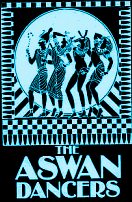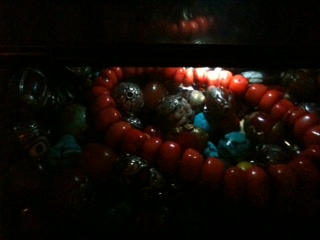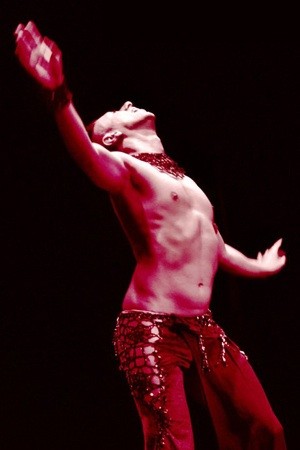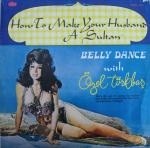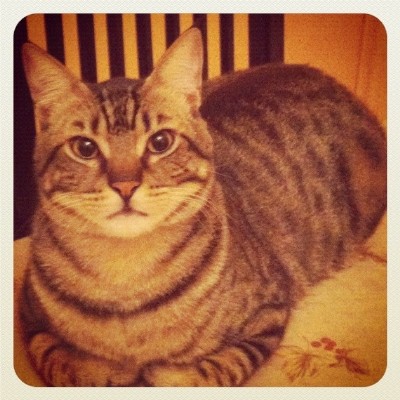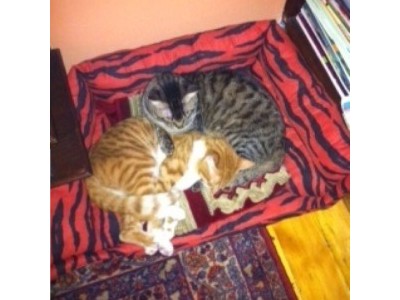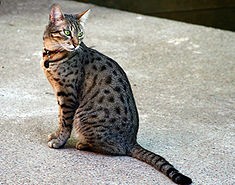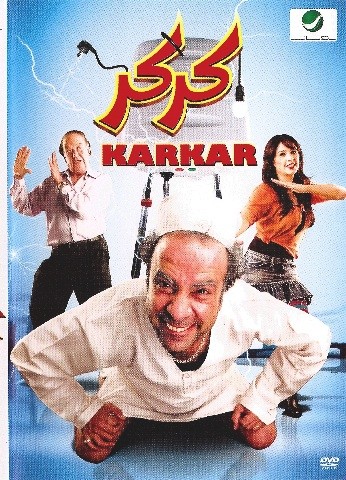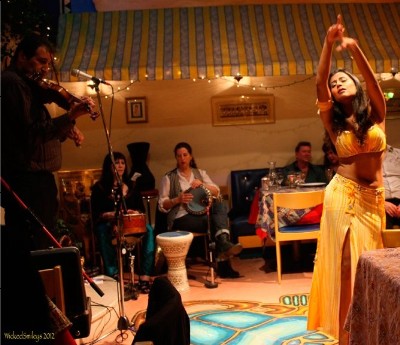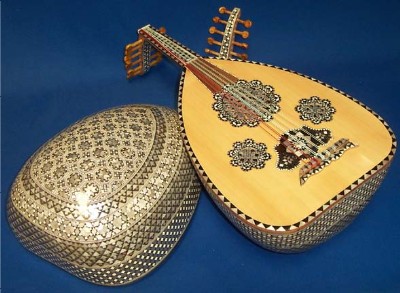Ba Olek Eh - Amina's Daily Blog
(tell you what)
May 31, 2012
Thursday
Qawliya - Iraqi Gypsies
Last night I was telling Husain that I wished I could go to New
York and hang out at Alwan
for the Arts. This is an organization with the same type of mission
statement as the Giza Club. Alwan has a home in an separate
facility, not like the Giza Club whose address is the same as mine. Alwan
has staff curators, volunteers and supporters with money and grants. The
Giza Club sometimes has volunteers and help but money rarely flows in
as we usually host events that are free featuring topics of interest to
Middle Eastern dancers.
The Giza Club has been hosting free potluck parties and events for over
twenty years. It began because when The Aswan Dancers performed they wanted
people to know more about the cultural background behind the music and
dance. The Giza Club is in San Francisco, which is the second most densely
populated large city in the United States with close to 800,000 people
within 47 square miles.
Alwan for the Arts is in New York City, which is the most densely populated
city in the U.S. with over 8 million people in over 300 square miles.
It is an Arts and Culture organization that promotes the understanding
of, and fosters appreciation for, the diversity of cultural experiences
and representations of the Arab world and of South Asia. It strives to
create a platform to reflect the artistic expressions and intellectual
production of the regions and their diasporas and allow New Yorkers, both
Middle Eastern and non-Middle Eastern, to enjoy the arts from that region
of the world.
I had gotten a notice about a
panel discussion:
Dancing Culture and Controversy: Professional Women Dancers of the Arab
World.
One of the panelists would be talking about and demonstrating Iraqi
Qawliya dance.
I asked Husain about this and he gave me an earful. Basically according
to Husain, Qawliya is not a word to be used among mixed company or people
who you don't know very well because it's a "bad" word. It implies
people who are low life and prostitutes. They are the gypsies in Iraq
and their culture is not to be considered Iraqi. I wanted to be doubly
sure on this so I asked him again and this was his reply:
"That's right but they sing and dance very well, Qawliya is very
bad word to say in public or to any one in Iraq, If you want to mention
qawliya you could say ghejer that means gypsy."I decided to do
a little research on this and found that there is a town in Iraq called
Qawliya. According to a Seattle
Times news article in 2004, In Qawliya, Iraq:
"No one lives here anymore.
A month ago, Qawliya's collection of perhaps 150 homes in southern Iraq
contained a small red-light district, an isolated warren known for prostitution
and gunrunning and as a haven from the law. Today, it is destroyed, the
few sounds of life made by barking dogs and scavengers piling bricks form
razed homes.
Its residents - hundreds of men, women and children, mostly members of
Iraq's tiny Gypsy minority - were driven out by a militia controlled by
a militant Shiite Muslim cleric, residents and police. Neighbors systematically
looted it. Some accounts say the village was burned, though the militia
denies it.
No one has been punished, police say. The U.S. led occupation, which learned
of the raid soon after it happened on March 12 (2004), has yet to make
it public. Qawliya's residents, most of whom fled to other cities, largely
remain in hiding, fearful to talk...
...Accounts diverge on the precise sequence of events that led to the
destruction of Qawliya, a village of concrete and brick homes perched
along a drainage canal about 100 miles southeast of Baghdad. Inhabited
by more that 1,000 Shiite Muslim Gypsies, the village was synonymous with
its people - qawliya is an Arabic word for Gypsies.
For decades the activities here, sharpened by a prejudice that tails the
handful of Gypsy communities across Iraq and the Arab world, had generated
local resentment.
"You know this village. It's a Gypsy village." said Brig. Hamid
Abed Zeid, the deputy police commander in Diwaniyah. "You know what
goes on there - illegal activities, drugs, crime, looting. You know these
activities are against Islamic injunctions."
Besides the drugs, prostitution and crime, the Qawliya, Gypsies originally
from India are also known for their music and their dancing and in Iraq
are entertainers.
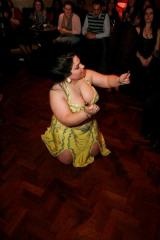
It's no wonder these entertainers get such bad press. It's hard to get
past this prejudice with the music and dance so tightly interlinked to
the oldest profession. Here in the West when we just want to study out
of curiosity and then perform coming from a love and passion for dance
and music in general, it's easy. But, if we are actually in the culture,
would we be doing it for the same love and passion for dance?
I know. I've just opened a can of worms. This is also something that has
been an issue with dancers in other Middle Eastern countries and in Egypt.
And when I am in Egypt, do I tell people that I'm a belly dancer? Absolutely
not! OK. I guess this is a subject that I'll keep visiting in future blogs.
May 30, 2012
Wednesday
The new tars
This was our last instrumental rehearsal for the June 3 Aswat concert
so I took out the song list and started writing down - finally - the rhythms
that we'll be playing. While Susu is still making changes with
a pencil, I'm using a pen knowing that I have several copies of the set
list. Sunday morning before the show I'll make the final final copy.
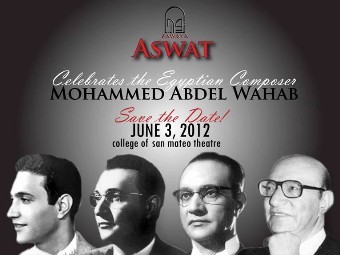
Even though we now have finalized what instruments we will be playing,
I'm still trying to decide which tar I'll use for which pieces. I like
them both, but think that I'll use the smaller one for the Arabic folk
medley and then use the larger one for the Abdel Wahab section.
The other girls will also use tars in the Abdel Wahab medley and then
mine will be tuned a bit differently. It's pretty exciting playing the
new tars and I'm wishing I could master the technique better.
Tonight at practice I spent the entire time concentrating on the tone
and how and where I'm placing my hands. I'm finally just letting the rhythm
changes happen automatically. When you practice enough times, your hands
just play the rhythms without even knowing how or why it changes to other
rhythms. That's a really great feeling to just be on automatic.

A while back I gave Susu "I
Loved You for Your Voice"; It's a book by Selim Nassib
and is:
"The story of the Arab world's greatest and most popular singer, Umm Kulthum, told through the eyes of the poet Ahmad Rami, who wrote her lyrics and loved her in vain all his life. Spanning five decades in the history of modern Egypt, this passionate tale of love and longing provides a key to understanding the soul, the aspirations, and the disappointments of the Arab world."
Although it is strictly fiction and based on conjecture, it nevertheless
is based on fact and therefore offers a very true and personal accounting
of the lives and times of Ahmed Rami, Umm Kulthum, Mohamed Abdel Wahab,
Mohamed Qasab and even Asmahan.
It's a very moving and powerful story and gives insight to the hows and
whys of the songs created for Umm Kulthum. Susu finally finished the book
and told me that it affected her a great deal. She said that it was a
book that could be read and reread and should be passed on to other special
people. Tonight she passed it on to Faisal.Home
May 29, 2012
Tuesday
Greek to me
I spent the morning working at the Arab Film Festival office screening
submissions and copying them for the selection committee. I hadn't been
to the AFF office in about a week and it was amazing to see how many new
submissions had arrived in just that short time. I usually try to finish
a project before I leave but there were so many submissions that I couldn't
finish my screening and cataloguing project. I had to stop halfway.
As I might have mentioned before, the first pass of my screening duties
is just to check for formatting issues so I really didn't get to see anything
in its entirety. But from what I saw, this batch is pretty interesting
and I can hardly wait until I get to watch them from beginning to end.
Besides the shorts and documentaries, there are quite a few full-length
narratives or movies. And, yay! there are even Egyptian ones. I guess
I'm a bit partial to the Egyptian films because besides watching them,
they are also a language lesson for me. With the subtitles and the words
that I understand they really do help me piece together my (Egyptian)
Arabic. The language of the other countries - especially the North African
entries sound like "Greek" to me.
When I was talking to Husain about this, he told me that North African
films aren't that popular in the Middle East because they can't understand
the Arabic and have to read the subtitles too. He said that now that he's
been living here in the U.S. and has friends from all different Arab and
North African countries, that it's easier to understand the different
dialects, but that he still needs to read the subtitles. I remember when
I used to work at the Bagdad and the Casbah with Moroccan
musicians who didn't speak English; the Arabic musicans would have to
use sign language or speak in French to be understood by the North Africans.
Babel, babel, Babylon, Too many dialects.Home
May 28, 2012
Monday
Memorial Day
I watched Gregory organizing his necklaces and tried to give some
input. He wants me to help him decide what to use on certain necklaces.
I have my ideas, and although he asks, I think he really doesn't want
to hear them. He already has decided on layouts according to tradition.
Most of my ideas are not according to tradition as I like to mix plastic
with real; modern with antique and rhinestones and pearls with everything.
Pearls are my birthstone. I don't know if I'm drawn to them because I'm
told they are my birthstone or if because they're my birthstone, I like
them. Maybe it's a little of both or did I just say the same thing in
a different order?

In reality, I like pearls because they remind me of my grandparents from
the Philippines. They would always bring me little souvenirs from the
islands and oftentimes they were pearls, especially big bluish and dark
almost black tinged ones. I like to compare them to the Tahitian pearls.
Mine are better because they're from my grandparents. And I like to think
that my grandfather found the pearls in the sea along with the seashells
he would bring back to me. Of course I always wondered if the tortoise
shell jewelry they also gave me were from the giant sea turtles that my
uncle told me he rode.
Well, I still have all these great memories of the Philippines and now
I'm into collecting shells and pearls of all different colors and making
up my own memories. I know my colored pearls are really dyed, but that
doesn't matter. I think it's neat that they are all different colors and
for me they have secret stories.
In Gregory's collections are pearls and shells that also have special
stories. These are stories of the migrations of groups of people moving
from one country to another and stories of the pearls and shells and other
beads being traded and used for currency. Soon he will have his collection
together to present at a Giza Club event. He will have wonderful
stories to tell of how a shell from the sands of the South Seas travelled
over various mountain ranges and continents and ended up in the sands
of the Sahara. Home
May 27, 2012
Sunday
Just a typical Sunday
Started the day off with Aswat practice. Rehearsal went well but
I had to leave before the end because Husain had to get to Al
Masri and I had to get to Pachamama. Both places were having
live music, so Husain needed to play with Mohamed and I needed
play (but really to coordinate the dancers) at Pachamama. Pachamama started
off kind of slow and in the beginning it seemed that we had more people
on stage than in the audience. There was Georges, violin; Gabriel,
guitar; Fernando, drum set; Angela, violin; Eddie, keyboard
and bass; Tony, tabla; and me, riq and duf. Later, they invited
yet another musician to join us on bass. Crowded? Zahma? Oh no. At least
it wasn't if we didn't move. And we didn't as there was no room.
Our audience was great. At first it was all dancers and their friends
and later more dancers from the Carnaval parade showed up. Without
Husain the music was more fusion sounding but then Angela would jump in
with a solo every now and then and bring us back to Araby. Georges was
in good form and because he sometimes works with the Pachamama band on
other nights, he has trained them to learn quite a bit of Arabic music.
They really do a great job in fusing the two sounds.
After the dancers performed, Georges and gang, including Tito?
on bass, played great Latin Arabic Jazz for the audience to dance to.
Tony was busy with his rumba, karachi rhythms so I felt free to try out
some conga patterns on the duf which was on a stand. Since Tony didn't
glare at me or stop me, either he didn't notice or I was fitting in. I
hope it was the latter. After all, I did take three years of timbale and
conga lessons. Finally I was able to put some of it to practice. I wonder
if I should start practicing congas again. Who knows, maybe in another
10 years, I'll have another opportunity. Home
May 26, 2012
Saturday
Drum Solos
Today in class I worked on drum solo combinations. It was a great feeling
to know that the class is finally getting it. The drum riffs are starting
to become as familiar as the drum patterns. The only problem is that if
I say beledy, maqsoum, ayoub, fellahi, the class recognizes and knows
how to count, play or dance to it. But how do I categorize a particular
drum riff? Do I call it drum riff #1, #2, #3 or what? Susu names
various drum solo arrangements as Standard, Henkish, Yazbek etc.
but that only describes the whole arrangement; not the individual riff.
I think I need to start making up interesting names. But what? Dum Dum
tek teks? Pop Pop Pop teky? Duma Duma Dum teky? Scratch teky Scratch pop?
Rekatek Rekatek Rekateky dum dum? The list could go on and on and on.
Should I really make a list? Should I really make up step combos to fit
the individual riff? This is so anti spontaneous to what a drum solo should
be. I don't know if I should, or even could work out combos. But, I think
I could teach how the drum riff combos work and then according to Susu,
if you can say it, you can play it, and to go even further, if you can
say it you can dance it. Home
May 25, 2012
Friday
The mall
Today Susu and I went shopping at the mall. We're going to a wedding
next week and want to wear something new and special. It's summer in the
mall and all the clothes look like floral arrangements. Bright light happy
colors. The clothes are so unSan Francisco. Since this is a city that
seems to have no seasons, we can and usually wear black and boots all
year round.

But in the mall, it's springtime, it's summer, it's color and happiness
and its infectious. The temperature is controlled and we don't realize
what the weather is like outside. We both buy pastel colored light cotton
tops that are reminiscent of an impressionistic painting in the deYoung.
When we leave the mall and return to the San Francisco fog we're both
carrying a bit of summertime in bags. I'm sure that later when we don
our new tops we'll wonder what possessed us to buy tops so unlike us and
the climate we live in. Maybe change is good. Maybe it'll be like being
on vacation.
Susu left to go home and before I could unpack my new purchases the doorbell
rang and there was Laura at the door. She wanted to borrow a couple of
costumes for the Carnaval parade, which was happening on the weekend.

She remembered that I had a box of tiger print Sheena of the jungle
ragged skirts and tops. We quickly found the box and chose the tiny little
scraps of cloth that doubled as outfits. After we put the two costumes
in a bag the size of quart size ziploc, I remembered that I had to buy
a wedding shower present, so Laura and I went back to the mall.

After buying the present we stopped in a shoe store.
She needed shoes to go with her Pebbles and Bam Bam costume and
I needed something sensible for the wedding. I found just what I needed!
Five inch raspberry
Day-Glo stilettoes with lace and pink rhinestones. Now to find the appropriate
outfit. I don't think I want to go as an impressionistic painting anymore.

Home
May 24, 2012
Thursday
Wahashtini
I made copies of the lyrics of the song "Wahashtini".
In class tonight we listened to the song while reading the words and working
on the pronunciation. I selected a few words to concentrate on as they
come up in many other songs.
negm, negoum - star, stars
kilma, kalam - word, words
hawa - air, love
kul el youm - every day
ta3al, ta3ali -come, come to me
Helm, Halam, dream, dreams
khaif, khufee - afraid, my fear
bokra - tomorrow
Then we listened to the song for the rhythm changes and finally put the
whole thing together and danced it, very slightly miming a few words for
reassurance.
It's a process and it takes time to combine everything - words, lyrics,
instrumentation, phrasing, emotions, technique, arms and stage presence.
But it can be done.
It didn't quite happen tonight but I'm confident. Next week we'll work
on the same song again. We'll work on it kul el youm until we feel
confident about the presentation.
The song was originally performed by
Soad Mohamed (1935-2011) and her version is quite beautiful and classic
sounding. Khaled Agag made it a hit in Egypt awhile back but it
sounds like he used a drum machine and Nur Mhana's version with
a full band and horns seems to be considered the default version. When
I teach the song, I try to remember to sometimes play all three versions
because they all have a different feel.
Although I've used "Wahashtini" in class and have never wanted
to dance to this song, I think it's my duty to at least teach to it. No,
I've never performed to the song and probably never will because for some
odd reason it's just not on my list of favorite songs.
The first time I heard Wahashtini was over fifteen years ago on a plane
on the way to Egypt. I was with Jacques el Asmar and he played
Nur Mhana's version non-stop on the plane. By the time we arrived at the
airport, I had decided that I didn't ever want to hear the song again.
But it seemed that Egyptian (Shaabi) singer Khaled Agag had made the song
a hit and his version was being played everywhere in taxis. Then at the
clubs all the singers were singing Wahashtini so by the time I got back
home, I'd had it with the song. Even though it seemed to be the big hit
song, it was just driving me crazy. Also, since we had a dance band, The
Arabian Knights, performing every week we had to play hit songs. Guess
what! Wahashtini!!! How can you miss something if it won't go away.
Washashtini
waHashtini 3adad negoum isama
I missed you as much as the stars in the sky
waHashtini 3adad kalam il hawa
I missed you as much as the words (talking) of love
waHashtini fee kul al youm innama
I missed you every day but (however)
waHashtini aktaru we aktaru weHnass suwaa
I missed you more and more even when we‘re together
ta3aly nakhaly alHalam Ha’ee’a
Come let’s make dreams (come) true
ta3aly na3aod kul da’ee’a
Come and make up every minute
min khufee la bokra ya fara’na
(from) my fear tomorrow could separate (divide) us
weHna ya roH ‘alby ma Sada’na
we are my heart’s soul - we didn’t believe we’re together
ash te’t leek wara ga3atleek we’elet leek waHashtini
I missed you and I came back to oyou and told you I missed you
Home
May 23, 2012
Wednesday
The Yuval Ron Ensemble
Tonight Husain and I played with
Yuval Ron and Dror Sinai
at the Osher Jewish Community Center in San Rafael. We played for a book
release/book reading celebrating two authors in an event called "Muslims
and Jews: A New Song".

The authors were Sarah Isaias and

Nafisa Haji,
two young, beautiful, soft-spoken women. But we can't just judge a book/person
by its cover. These two women were also extremely articulate and had accomplished
so much in their young lives.
When we were having sound check and rehearsing our set, Yuval wanted to
choose the frame drums that Dror and I would play. . We were going to
play a sufi song and Dror and I were both going to use tars. We had four
for Yuval to choose from: Dum - "this is an 'A'"; Dum - This
a 'B flat'"; Dum - "This is a 'D'"; Dum - "This is
out of tune". We went with the 'D' and the 'A' tars.
In all, it was a very nice evening and presentation with mostly Jews,
many of them Arab Jews. I think I would have called this event "Jews
for Islam: A "Love-in". Peace and love seemed to be the predominant
vibe in the room. They certainly won my heart with all the little pastries
being offered... especially the date ones.
Now I'd like to post some thoughts about the event that Rebecca Firestone
wrote.
"Hi Amina,
That was a very interesting evening. Both authors were very articulate
and worthwhile. Evening was well put together except there was too much
talking at the end, it started to get a little vapid.
Band sounded good. The sound could have been a little better - probably
a limitation of the hall and the equipment. Interesting that "Lamma
Bada" has a Hebrew version, not surprising, too bad they didn't sing
the Hebrew! There is also a Spanish version on one of Radio Tarifa's albums
with a Flamenco flavor (the dream of the sultan, paradise gardens of love,
how sad the awakening to find nothing).
I was hoping to see the Aswan Dancers, who would be a lively addition.
Maybe next time.
Sometimes I have mixed feelings about the "peace" themes. I
wish that Yuval Ron would concentrate on the music and not lay it on with
a trowel. And not over-simplify the musical commonalities in the name
of "it's really all the same". Let the music speak for itself.
And if you're working for peace, don't disguise it with music. Get out
there in front of the bulldozers and do some straight talking. Feeling
good with rich white people in Marin does nothing for Palestinians who
are in jail now, or unemployed, cut off from water and livelihoods.
Even though a few aspects of the presentation didn't work for me as an
audience member, interfaith explorations and open discussions are always
worthy attempts and steps in the right direction. The fact that both authors
were galvanized by 9-11 but instead of denying religion, they reclaimed
it - very important. Can't let the atheists get all the peace credit,
can we? The JCC program director who chose those authors and moderated
the discussion took a risk and should be praised for her efforts. "
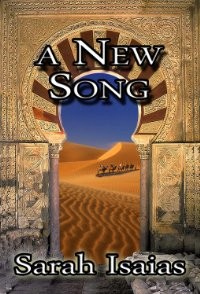
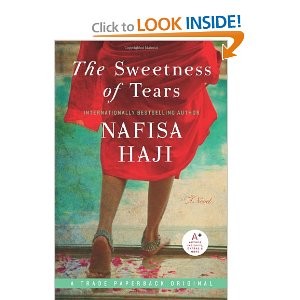
Yes, it was an interesting evening and I am glad I played hooky from Aswat
to be part of it. I really enjoyed both women and ending up buying both
of the books. Now I can enjoy the evening for many more evenings to come.
Of course, I'll have to provide my own date pastries.Home
May 22, 2012
Tuesday
Frame drums
Susu came by today and we played with the new bendirs. They are so beautiful and special. They are truly a work of woodworking art.
A few years ago Faisal told me I should invest in one, but I only
got as far as checking them out online. Now that I have them, I don't
know why I waited so long. I think that with these bendirs, I stand the
chance of maybe becoming a good frame drummer. I know that sounds so funny.
It's always funny when I tell people I'm in a band and I see a disguised
smirk when I tell them I play the tambourine. I wonder if I'll get the
same reaction when I tell them I play a frame drum. For some reason, I
think they'll think the frame drum is a more complicated instrument because
it has the word drum in it.
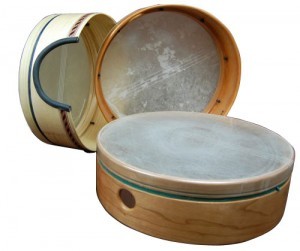
An interesting thing about the frame drum is that most people want to
play the tabla, dumbek, derbekki or darabuka and not the frame drum...including
me. That is, it used to include me until I realized that the drummer,
the tabla player, was responsible for keeping the band together. Oh no,
not me. I don't want that responsibility. I think I'd rather be a frame
drummer and just be part of the band.
The tabla, dumbek, derbekki, darabuka are some of the names for the Arabic
drum and duf, muzhar, tar and bendir are some names for the frame drum.
But once a person learns to play the drum, not the frame drum, if invited
on stage to sit in or play with a band, unless that person has an "in"
or already is a known talent and skilled drummer, that person almost always
inevitably is handed a frame drum. Yes, there is a tekking, I mean pecking
order, in this drumming business. You have to prove yourself competent,
no, more than competent, in order to play the drum.
Obviously this is a good thing; not a bad thing, except: "How does
one play a frame drum"? Most drum teachers teach drum but not frame
drum (maybe Moroccan rhythm teachers are an exception). In good Arabic
and Egyptian bands, traditionally there is a frame drum section almost
as large as the violin section. One frame drum is never enough. It is
a very important instrument in the Arabic band.
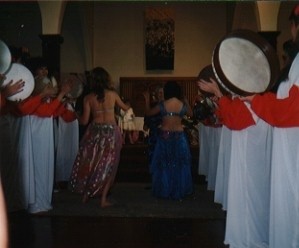
Unfortunately, due to economics, at least here in the U..S., there never
seems to be enough desire or money to include more than one percussionist
such as a riq player, let alone even one frame drummer. And, due to everyone
wanting to learn to play the tabla, there aren't that many frame drum
classes. This is really bad because then when a tabla player is handed
a frame drum, he/she may not really know how to play it. Besides the fact
that the dums and teks are not in the same places as in the tabla, there
are a lot of different skills and technique involved and because it is
a back-up instrument, the rhythms are played differently.
Most frame drummers here learn as they perform. That's how I've learned
and am still learning. With my new bendirs (frame drum with a snare -
usually used in Moroccan music) that double as tars (same as a bendir
but without the snare), I'm hoping to someday really play it well. Of
course this takes time. With another birthday just around the corner,
I hope I have enough time. Home
May 21, 2012
Monday
The bendirs arrived today. They are sure beautiful and
sound great. They are light in weight and have such a great and delicate
tone. I sure wish I could play better. It's not fair that some people
have that god given talent and waste it and others who so desperately
want to be good musicians have to keep looking for better and better instruments
to make them sound better. I guess I should just quit complaining and
just start practicing more. I think one problem is that I do practice
the tabla and the riq, but really don't practice the frame drum that much.
Now I have a dream that someday I and about five other people can back
up a band and play the frame drums - the dufs - and make that great and
big sound like they have in Egypt. I do have a few DVDs with Susu and
various permutations of The Cairo Cats playing the dufs sounding
like that, but those were just special instances. The Cairo Cats originally
were a revolving group of Arabic musicians, such as Reda Darwish, Mohamed
Amin, George Dabai, Nazir Latouf, Jad Elias and more, who were headed
by Susu and her percussionists. Although the musical portion of
the band may have changed from show to show, the percussionists who backed
them up always stayed the same. Although the percussionists were many,
some of us couldn't always play with the band as we often had to double
as dancers.
It's been my dream to have a band with that many dufs ALL the time. Possibly
it will happen again, but when? Probably sooner than later since now we
don't usually double as dancers.Home
May 20, 2012
Sunday
Sound
Last Wednesday Najwa, who is from Lebanon, gave
me a large garbage bag full of cassettes with Arabic music. She was cleaning
up and since she doesn't have a cassette player anymore, she decided to
get rid of her cassettes and I inherited them. I haven't yet had a chance
to play them but upon looking at them I realized that they are mostly
Lebanese music. There's nothing wrong with Lebanese music, but I'm more
of a fan of Egyptian music and also don't really know a lot of the Lebanese
popular singers other than the top stars who also made it Egypt. I will
probably take my time listening to and copying these cassettes. There
are so many, that I know I'll have to be very discriminating in what I
choose to copy.
Today Ayman gave me 3 DVDs. Two are full of music - of course it's
Egyptian music and one DVD is "Halim", the docudrama
of Abdel Halim starring Ahmed Zaki. I can hardly wait to
find the time to start listening to all this music and downloading it
and transferring it to CD. I know I should get used to just having music
on little devices like my iphone, but I really need to touch and feel
my music sources such as CDs. Maybe someday I'll feel differently but
I'm not ready to change yet.
Tonight the way home from Aswat, Husain was playing Mahmoud
el Leithy's new song "Souq el Banat" continuously
like a loop. He's ready to start performing it. I wish I had a CD of this
song. It's a nice song, but I just can't enjoy it that much when listening
to it on his phone. It just sounds distorted. Sometimes when I copy CDs
from my computer onto a CD they sound pretty bad too. It seems like each
newer system of music makes the sound one level more degraded an the sound
quality keeps getting worse and worse.
I think that records and cassettes were the best for fidelity, CDs are
ok but when it comes to the computer or iphones or those other devices,
they sometimes lose quality big time. Maybe it's not all that noticeable
or important unless you're a fanatic audiophile but I swear that a lot
of the music I download just has no depth and sounds way too flat.
I'm not a real audiophile but it matters to me when I can tell the difference.
Home
May 19, 2012
Saturday
Drum solo class and more.
A little bit ago, Hana and Kim asked me
to arrange a "How to dance to a drum solo" class with
Susu. Trying to coordinate schedules proved almost daunting, but
finally we arrived at a date but also realized that we (Susu and I) had
to be somewhere else in the early evening.
Susu wanted to limit the class to six people so that it would feel intimate
and everyone could have lots of attention. Well, I think it worked, but
we ran out of time and we'll have to continue the class and make it a
two-part class. Now, given the background giving insight on how a drummer
operates and the formula a drummer may use, I think the second part of
the class will be even better Now, to try to coordinate schedules again.
We (Susu, Husain and me) had a performance for the 35th Anniversary
of The English Center, an ESL school in Oakland. We were part of
their multicultural program and I was supposed to dance and then teach
the Arabs how to dance. Me? Teach Arabs how to dance? I was to teach men
and women and not teach any "belly dance" moves because they
were mostly from conservative Saudi Arabia. I told Husain to play Saidi
and I did a stick dance and told them that women did this to make fun
of the men. Then I took two large assayas (sticks) and showed them how
the men did the tahtib which is very stylized Egyptian martial arts. This
was fun to do and watch but they weren't very aggressive so I had jump
in with my stick and stir up a little trouble.
After our show, we left in separate cars - Susu to a Tribal Fest
Show in Sebastopol and Husain and me to Zaki's, a kabob place,
in Albany where we arrived in time to play a few songs with Jalal
and then relax and have dinner. The owner talked to me about doing a debke
show at his place and I told him that I would try to find him some dancers.
Good luck! I'll try, but most of the debke dancers I know won't dance
at weddings or restaurants. Husain asked me to teach him debke. I actually
toyed with the idea of doing the gig myself but it's too soon - like on
the same weekend as Sahra's event. Teach Husain
debke? Then who would sing? Home
May 18 2012
Friday
Carnival of Stars
I spent the day on my computer. I hate being on the computer.
There are so many other projects I would rather be doing than uploading
stuff on my website. But I guess this is a necessary thing. I remember
when I used to spend hours cutting and pasting (with paper) making flyers
and then addressing, stamping, sorting and mailing so I guess the computer
does serve a purpose.
I just don't like it. I don't have a computer mind and my computer knows
it and doesn't like me. Also, I feel my computer is as old as I am and
wants to be traded in for a new model. Well, I'm not trading myself in
anytime soon and neither is my computer. In the meantime, it'll just have
to keep having it's aches and pains AND crashes. And in the meantime,
I'll just have to be patient and nurturing and hope it doesn't die on
me.
I'm starting to get sign ups for the side show and I've noticed that most
of these people are not from my classes. I don't know if that is because
my classes assume I will just assign them a dance slot or if they don't
want to dance. I need to check with them and see. Or maybe I should just
fill in their names and make them dance. No, I shouldn't do that. But,
one thing must be for sure - and that is that they must not read my emails,
look at my website or check my blogs. Home
May 17, 2012
Thursday
Warda
Today was a sad day. Warda
al Jazairia died today, so in class tonight we read her obituary and
played her music.
I chose a number of her songs to dance to tonight but for performance
we used Tab Wana
Mali. It was a Warda song that is so popular that there are numerous
versions done by other artists. Originally I chose this song because it
has a great fast musical section and I wanted to use cymbals in that part.
However, Nayan showed up for class with Jenna her 6 month
old baby and I didn't want to disturb the little one with our clacking
and clanging so I decided to just concentrate on the dancing. We can always
use cymbals another time.
On June 10 at Pena Pachamama, Gunsu will be singing a Warda song.
This will be a fun night winding up the Sahra
weekend of workshops. Gunsu is a Turkish singer and also a dancer. I met
her years ago when she sang with us - The Arabian Knights Band
- at El Valenciano. Then she stopped for a while to get married
and have a family. We remet at Aswat where she sings and is one
of our featured soloists. She usually sings an Om Kalthoum song,
but for June 10 she had planned to sing Warda. Because Warda died today
so this turns out to be a fitting choice. Fee Youm we Leila.
Home
May 16, 2012
Wednesday
What to play
I decided that I want to play the tar for the Aswat
concert. Susu got me a bendir/tar as a Mother's Day/Birthday present
and it is due to arrive next week. I'm so anxious to get it and start
playing with it. I know that I have other tars, including two beautiful
ones I got from Alfredo, but they have real skins and are really
dependent on dry warm weather to sound good.
I don't want to use heating pads on them because it's bad for the skin.
It's kind of like our own skin. There's only so much elasticity to go
around and once it's stretched, it's hard to shrink back unless it's done
very gradually. Just like in humans, especially the face, elasticity seems
to disappear with age so since my two good tars are way over 20 years
old, I don't want to ruin them with the heating pads. My new tar will
be tunable with a synthetic head. Since I'll be getting the new tar next
week, it will be so exciting to use it for the show.
Tonight Faisal wasn't at practice so I played the tambourine. It's
good to play different instruments but I guess I really should start using
the tar. Next Sunday, Sandy will bring her Cooperman tar
to practice so I can practice with that until I get mine. I know this
sounds so inconsequential and insignificant, but it is like getting a
new pair of shoes. Exciting! And it's especially exciting when they fit,
feel good and look good. That's what these Cooperman tars are like.
Jose Antonio, an Aswat singer from Chile, came to practice tonight
and we had to learn yet another new song for the concert. When will this
end? Learning the song isn't the difficult part. It's because the song
will be part of one of our medleys that makes it so hard. We have to (seem
to) instinctively and seamlessly morph from one tune to another. Just
when our bodies and hands start to go on automatic, we get another wrench
thrown in the middle of the chaos. And they wonder why I'm not bothering
to write down the changes - yet. As I said before, Susu does, but with
a pencil with a HUGE eraser. Home
May 15, 2012
Tuesday
Trance and dance
Sometimes I wonder why I teach class. Is it my own personal
health spa? Is it to share what I know? Is it a social thing? Is it moving
meditation? Is it my way of continuing to perform, or network, or a reason
to listen to music and to create, to not eat, just my enjoyment? I guess
it's all of that and more.
Tonight it was moving meditation. I chose to play Mahmoud el Leithy
in class and his songs are very trancelike. Mahmoud el Leithy was born
in Imbaba which is a Shaabi (aka popular) neighborhood in the northern
part of Cairo. Thanks to his beautiful voice, talent, unique singing style
and a lot of perseverence he was able to take his voice from mulids and
weddings to the recording studios and finally to us.
In class sometimes I play some of his trance and zikr-like songs and they
seem to take us on a musical and spiritual journey. I like doing this
sometimes because dancers who have inhibitions and/or have trouble doing
certain movements, especially shimmies, can sometimes relax enough with
his music to be able to shimmy or move gracefully. Once that happens,
then it's easier to replicate and do again in other classes and hopefully
in performance. Sometimes it's just the simple act of doing instead of
thinking that helps.Home
May 14, 2012
Monday
Migrations
Gregory is serious about assembling necklaces for
his Silk Road exhibit. I'm pretty excited about it and am starting to
think about what videos I can show in conjunction with his collection.
His bead collecting started as an alternate to collecting folk and especially
New Guinea art because we ran out of room to display the collections.
Now his bead collecting has taken over his life and gone down different
roads. This last direction is all about following a different Silk Road
from the Far East over other mountain ranges through the Middle East and
into North Africa.
It's kind interesting to see what people were wearing and trading when
they travelled and to see how the beads ended up in the most unlikely
places.
"Migrations". Maybe that's what we should call this future
Giza Club event.
I really like trying to follow dance and musical connections from Asia
to the Middle East and North Africa. The jewelry aspect is a whole other
element of tying all these cultures together. This is a truly exciting
project. Gregory is slow to share but now that he's on the final legs
of his project he's finally showing me some of his pieces. Now my job
will be to assemble the audio visual media portion of this amazing show.
And of course, we shouldn't forget the food connection and trail. But
maybe that'll just happen naturally at the Giza Club.Home
May 13, 2012
Sunday
Helwa Ya Sabah
Happy Mother's Day. Before going to Aswat I spent
time with my mother and
the rest of my family. My niece, who is a photographer, has been spending
quite a bit of time transferring old negatives to digital photos. Today
we got to see her progress. Usually no one else enjoys family photos except
the family who is in them. But these photos, mostly black and white photos
were universally interesting as a retro exhibit because of the old cars,
the hair dos and the fashions. I hope to put some up when my niece finishes
this project
.
One thing that was especially interesting to me is how the the hippies,
the "love generation", the "age of aquarius" really
changed the world and the idea of dressing up. These black and white photos
show us (my family), both men and women, wearing real hats (not "knit
or baseball caps") matching shoes, purses AND gloves. Absolutely
no one went "to town" without dressing up. I kind of miss that.
When I think about Americans travelling in other countries, it's a shame.
You can always spot them/us. We're usually the ones who look the worse
- the most casual.
It's been fun going to Aswat lately. I'm getting to play my Shaabi music
without criticism now that Husain has seen the light. Yes! He's
a convert.
He's become a total fan of Mahmoud el Leithy and has been looking
him up on you tube. I have lots of Mahmoud el Leithy not on you tube and
I'm enjoying introducing Husain to new songs. It's not every day that
I know more songs than he does.
The new song for the day was " Helwa Ya Sabah". Husain
said the song was originally from a movie with Mahmoud Abdel Aziz.
He's one of my favorite actors and I haven't seen a movie of his that
I didn't like. I especially liked him in the role of "El Gentel".
I think this is available free to air if you poke around on the internet
long enough.
A version of "Helwa Ya Sabah" is on Yasmina of Cairo's "Helwa
di Yasmina" CD. What can I say? It's about saying "Hello
beautiful, look over here, I'm destined to unrequited love". Kind
of sounds like the same as "Taht il Shibak" and I guess
a thousand other songs.
The Mahmoud el Leithy version adds a totally new and modern dimension
to the song, and Husain really wants to learn it. I'm giving him a copy
and who knows, soon. Maybe real soon. It'll be on our set list when we
play at Al Masri or other events. Husain wants to give Susu and
me parts to sing. Susu? Yes! Me? I don't think so. Home
May 12, 2012
Saturday
Zadiel of Berlin
Joshkun of the Mendocino Middle Eastern Dance
and Music Camp contacted me about bringing
Zadiel to San Francisco. A while back Zadiel told me he was coming
to San Francisco in the summer, but as emails go, it got lost in the queue.
I'm glad that Joshkun reminded me that Zadiel will be here.
Zadiel will be teaching at the camp from July 7 to July 14 and then will
go to SFO to return to Berlin. I was able to reserve space for him at
Mobu on his one free day Sunday, July 15. He was here a couple of years
ago and taught some workshops in my studio. They were a lot of fun and
made me remember or realize that there is a totally other dance world
out there besides my Egyptian style that I like so much. Being of Turkish
descent Zadiel taught Turkish Romany style and made it accessible to us
Egyptian dance fans. It brought back so many memories of dancing at the
Bagdad and being in awe of the dancers from back east.
Because in the East Coast in the old days, the Middle Eastern community
had a lot of Turkish people and musicians, the dancers there all included
a bit of Turkish dancing in their set. They especially included a passionate
Karsilama ending. However, in San Francisco we had a predominantly
Arabic community, including Arabic musicians, so we didn't always dance
to Karsilama. But we did often enough to know that we couldn't hold a
candle to the East Coast dancers. And we wanted to be able to do Karsilama
like they did.
The other day Jalal asked me if I remembered how many Turkish dancers
we worked with (at the Bagdad and the Casbah) who were named
Princess Aisha. I said only one because the other was Aisha
Ghoul. Princess Aisha must have been truly a princess. When we thought
it was remarkable to receive $20 tips, she was getting $100 dollar bills.
Her fans said she deserved much more because she was a "princess".
Sometimes she also got real jewelry. Well, she was beautiful and always
wore a rhinestone tiara.
Aisha Ghoul, on the other hand, was a "down-home" girl. She
first lived in New York before coming to San Francisco. Since she knew
that I was a novice dancer, she took it upon herself to give me advice.
"Don't sit with the customers unless they give you something."
"I used to asked for money or fur coats (because in New York we worked
near the fur coat district)." When she wasn't sitting with customers,
or doing her "Sultan Act". "Come on shake your apples.
Now, shake your tree." (The Sultan Act was something we were required
to do that involved bringing a man to the stage and making him look foolish.),
she would stay in the dressing room and spit seeds. I mean the watermelon
and pumpkin seeds that she ate and would make the dressing room floor
look like the bottom of birdcage.
And then I remembered another Turkish dancer,
Ozel Turkbas who danced briefly at the Casbah. She created quite a
stir with a bra with fringe that was almost like pasties. I remember there
was fringe on the top but when she moved and the fringe swayed side to
side we could see that the bottom part was totally bare revealing lots
of breast skin. Well, it was decent, just reverse cleavage. Kind of daring
and we thought "Oh, so Turkish!"Anyway, this was in the late
60's or early 70's. She also wrote a "how to" belly dance book
and produced a few LP records. One was called "How to make your
Husband a Sultan". Of course, I still have this record. Do I
ever throw anything away? Remember, this was in the age of "anything
goes" and America is a melting pot and the musicians were a fusion
like the United Nations...there was one representing each country.
There were no purists then like there are today. Sometimes we were just
lucky if the musicians could communicate in a common language. Often that
language was either French or (broken) English.
Yes, it will be interesting to have Zadiel back and remember and learn
some Turkish dancing. Going back to Egyptian history, much of the dancing
that we got from the old black and white "Golden Age"
days had a lot of colonialist Turkish music and dance influence. After
all it wasn't until 1952 when Nasser gave Egypt back to the Egyptians.
Sometimes it's good to learn the roots of this dance. Home
May 11, 2012
Friday
Sahra Saeeda
One of the best things about this dance is the fast and
true friendships that are struck based on common interests and values.
I am no longer amazed that the women in my classes are so open, caring
and respectful of each other based on their love of the dance with little
regard to their innate dance ability or the size of their paycheck. Of
course those with natural born talents are looked upon with admiration,
but there is always that general love and supportiveness of each other
that one usually finds in close families. It's kind of unconditional love
based on the common bond that is belly dance.
Just as an aside; there's been a bit of talk right now on "What do
we call this dance?" Middle Eastern, Arabic, Raqs Orientale, Raqs
Sharqi, Oriental, Danse du Ventre, Belly Dance, or what? I usually
tell strangers that I teach Middle Eastern dance, but to my friends I
say belly dance. I know that rubs the wrong way with a lot of people,
but I guess it comes from my background.
I was a "belly dancer" on Broadway in North Beach for the first
twenty years of my dance career. And I was proud of it. That is a cold,
hard fact. But I also encountered a lot of discrimination and prejudice
using that term such as people thinking I was a "strip teaser"
or even a prostitute. I couldn't get a bank loan, good medical insurance,
car insurance or even a day time job at a health club saying I was a "belly
dancer", but I was treated differently and with a "little more
respect" when I said I was a (generic) dance "teacher"
and I was treated with a "lot more respect" when I said I was
just a housewife.
In order to survive, I learned quickly that I just didn't tell people
what I did. They were ignorant and didn't deserve to know. But later,
if pressed, I would eventually and sometimes reluctantly tell them that
I taught Middle Eastern dance. The reply would always be "You mean
belly dance"? And I would respond, "Yes, Egyptian style folk
dance". But to my friends, it was just plain belly dance because
they had no prejudgments.
Times have changed and now there are many Middle Eastern restaurants and
clubs with performers so there is also more awareness of what our art
really is. But there is still that underlying prejudice. Therefore, even
today when I am more of a dance teacher and less of a performing dancer,
I still do not tell people what I do until I decide that they're earned
the right to know. For me, it's just easier that way.
Getting back to our close-knit family of friends who share this dance,
I embrace this attitude, respect and camaraderie that we share that is
unique to our profession. What other profession allows us to be so open
and share so much - knowledge, aspirations and even self-doubts without
pre-conditions or the history of years of friendship.
In Aswat, we have a newly formed group called W.E. or the
Women's Ensemble. It appears that the women have joined together
with that common denominator of bonding as a result of fighting the discrimination
of the macho world that seems to belong to Arab musicians. Are we just
the underdogs? Do we get less credence because we are women? Is this true
about our dance as well? Do we naturally want solidarity in our "underground"
dance form that is millions strong? I think so. I think that we form a
mutual trust first, based on even a "say so" by a friend of
a friend of a friend.
I know this is how I met and got to be friends with many other dancers.
(Here, I am also including some of the men who also adopt this dance.)
Sometimes we only "knew of" each other and sometimes only by
name on a flyer. Usually this is due to distance, such as living in opposites
sides of America, or even the world. But, nevertheless, given short spurts
of time together, we dancers from other areas manage to instantly bond
in the way that families do.
One of the many dancers I got to know in this way is Sahra
Saeeda. I met her in San Francisco at a couple of workshops hosted
by Sausan, I met her musicians in Cairo, I meet her at BDUC
in Long Beach and we've met numerous times in San Francisco at various
shows and other events. Each time I would see her I wished we lived closer.
But we don't. But that's OK.
When we do meet, we just pick up where we left off. Just like families
do.
Sometimes I wonder why I was so happy that Hana asked her to come
to San Francisco teach her Saidi and Beledi Progression
workshops. Is it because she's going to share her knowledge in my area
or is it because we can just hang out a little bit? If any of you have
met Sahra, you would wonder too.
Sahra will be here June 9 and 10 and I hope you
will be too. Then, you too, can be part of her family and see what I mean
about our dance world and how we bond. Home
May 10, 2012
Thursday
The Cairo Cats, mau, mau
Debbie sent me a couple of photos of her Cairo
cats.
The original Cairo cat is over 3000 years old and is spotted with the
hind legs longer than the front legs for ease is running. They are known
to run over 30 miles an hour. I'd sure love to see these house cats run.
But run where?
We've been talking to Debbie about possibly bringing me a cat from Cairo.
Since our cat Bob has been gone a couple of years now, we're finally
ready for another cat. Abi was a cute cat, but not our cat. I wonder
if it would be possible for Debbie to bring us an Egyptian cat. It would
only be fitting and I am sure that, except for the weather, the cat would
immediately feel right at home. I suppose the cold temperatures would
surely convince the cat that the great outdoors is not the place to be.
Here's a cute song by one my favorite Shaabi artist's Abdel Baset Hamouda
singing "Pussy
Cat". Home
May 9, 2012
Wednesday
Husain borrowed back his tools
Well I lent Husain the tools he needed to fix Linda's
ouds. I wonder if I should just give them back or if he considers my basement
his storage unit. It really doesn't matter. Now, if I need something fixed,
I'll just borrow Husain.
It's been pretty great with Husain converted to liking some of my favorite
Shaabi singers. Tonight we listened to Mahmoud el Leithy in the
car to and from Aswat practice. Husain played "Souq
el Banat" continuously and plans to learn it and sing it as a
duet with Susu. He's wondering if he can do both of Mahmoud el
Leithy's parts. It's a cute song about looking for a bride,,. Not a college
educated one...one from the neighborhood.
This song comes from the movie "Sharia al Haram". In
the film, Ayten Amer dances while Mahmoud dances around her. She's
such a cutie and she acts, she sings, she dances. I don't know if the
song is available on CD here, so if I can figure out how to download it
I will. Home
May 8, 2012
Tuesday
Screening films
I've been spending a couple of days a week at the Arab
Film Festival office checking films that need to go out to the screening
and selection committee. Running the Festival is a year-long project and
part of the process is soliciting and accepting submissions, checking
for viewing compatibility and then checking for glitches. Although DVDs
are so simple to use, there is still the problem of formatting and sticking.
This can be a major problem when a DVD is presented to the selection committee.
Watching the films can be quite interesting and but also can be very depressing.
A majority of the films are about what we read in the news. Reading about
the Middle East and seeing these problems played out in film are so totally
different. I, for one, don't like to see pain and suffering but I know
that one object of the festival is to remind people of the difficult situations
in the Middle East.
I think I would rather go to a film festival to escape from problems rather
than face those realities. Maybe that's why I'm only working for the festival
in the capacity of screener for technical difficulties. Since I know that
I have a totally pollyanna point of view on life, I don't think any of
the Arab Film Festival committee would want to hear my opinion of how
to program a festival. If it were up to me, I would do a retro festival
starring Egyptian comedians.
Let's hear it for Mohamed Saad in "Lemby" or
"Karkar". Home
May 7, 2012
Monday
To do
I don't know why Monday always feels like the beginning
of the week since it's really just another day of the week for me. My
weekend is always filled with dance classes and Aswat practice
and playing at one club or another. Actually I've spent my entire adult
life working on the weekends. But my work doesn't really seem like work.
It's my enjoyment. So, I don't know why Monday is the beginning of the
week when it's just another day to me.
As I may have said before, I do look forward to Mondays. I always try
to start fresh and make my to do list for the week. At the end of the
week, I'm happy if I just cross off even one item off the list. This week
it's about organizing - as usual. I wonder if other people have the same
problems as I do. It seems my entire life has been spent trying to put
order to something. I don't think I'm very good at it but, believe me,
I sure do try. I keep getting junk emails about adults with ADHD. Do these
emails go out to everyone or am I targetcast? How do they know? Well,
even if I don't cross off much, these to do lists do help to keep me on
track.
Organizing my media is a major task and finding space to store all of
it is an even larger task. I think making space is foremost in my mind
these days, but for some reason I can't seem to do anything about it.
It might be time to just bite the bullet and purge!! The first purge will
be with my cassettes. OK - sometime in the next week or before the end
of the weekend, I will fill a couple of shopping bags with cassettes to
go out the door. I remember when I did that with some VHS cassettes. It
hurt, but in the end, it was a great feeling.
Of course I kept the "important" VHS cassettes and I will do
likewise with the audio cassettes but this will provide some much needed
space. Every little inch really does count. Home
May 6, 2012
Sunday
Where's the emotion?
After Aswat practice we went directly to Al
Masri. Even though I thought we were early, we walked into a pretty
full restaurant. That felt good, but also made me feel a bit anxious.
It's hard to try to set up mikes, wires, etc. while wanting to socialize
and greet people, not seem rude or distracted and also not appear worried
that one of our musicians was M.I.A.
It was a beautiful day. It was a rare San Francisco day. It was a no coat
day and this restaurant full of people had decided to be indoors with
us while one of our musicians, Mohamed Amin seemed like he didn't
want to be with us. After trying to reach him, we finally realized that
we needed to play without him. But I tried one last time and, il hamduli'lah,
he sleepily answered his phone. "OMG!" he said. The fine summer
weather had so discombobulated him that he forgot about everything except
thoughts of the beach in the warm San Francisco and then he fell asleep.
He sounded confused and dazed but promised to be there before the end
of the evening. We couldn't stall any longer, so we started without him.
Fortunately San Francisco is physically small and before our second dancer
performed he was there setting up his mike. The sounds of his heavenly
nai filled the room and we felt like an ensemble.
There was a full line up of dancers and they were all good. BUT to me,
some of the dancers just seemed to be dancing for themselves alone. I
mean - just concentrating real hard on the music and forgetting that there
was a supportive and friendly audience of dancers out there watching and
wanting to be included in on the fun. I know that this dance can be "internal",
but if the dancer is "too internal" why bother to dance for
other people? Just dance in your living room, or closet.
There was a great line in the Tunisian film
"Satin Rouge" where a new dancer does a great uninhibited
performance but the club owner didn't like it. He said something like
"Remember you have an audience and your performance isn't for
you alone, you need to entertain." This is so important to remember.
Here are a few other quotes to think about:
"She's a dancers' dancer." meaning great technique but
not interesting to the general public.
"She's a great dancer, but you could put a paper bag on her head
and it wouldn't make any difference. She has no expression."
"Wow, she was really fun to watch!"
"It doesn't matter what you feel, it's how you make the customers
feel." a club owner
"Tricks? (balancing acts, etc.) Who cares about tricks?
Your best trick is to be a good dancer." a club
owner
"I can't get into this dancer, how do I play for her? - she's
'closed'." a musician
I guess what we need to remember is to dance appropriately and expressively
according to the venue. If you want to do "art" dancing, do
it on a theater stage, but if you're dancing in a club, a restaurant,
a deli, a house party or a fair, your audience wants to have fun and be
entertained. That means give something of yourself. Be expressive. Entertain.
Your audience can only have fun or "get into your dancing",
if you are having fun or it you are inviting (with expressions - face
and body language -) your audience to be part of your performance.
"Let me entertain you!" Gypsy Rose Lee
Home
May 5, 2012
Saturday
Shaabi and its categories.
It's finally come to having to subdivide the various categories
of Shaabi music.
What is Shaabi? As a word it has multiple meanings in Arabic. It means
"folk", "popular ", of the people”. As a musical
form it is the voice of the street, an urban expression full of feeling,
double entendres, and social commentary.
Shaabi is the popular people, the working class people, the people of
the hara (a neighborhood, a neighborhood that may not have paved
streets, a neighborhood where the streets are really narrow lanes, or
alleys) and most of the Shaabi people were just one generation away from
the countryside. Now, it may be two generations.
The urban expression full of feeling, double entendres and social commentary
is still there, but the Shaabi world has become paradoxically wild and
conservative and the style of music shows more and more influence from
electronic and computer generated instruments. Just looking at a few popular
Shaabi singers such as Saad al Soghayer, Mahmoud el Leithy, Mahmoud
el Husseini, Shabaan el Rahim and their DJ colleagues specializing
in electronic and remixing
DJ Haha, DJ Chipsy, DJ Figo with accompanying rappers such
as Alaa 50 makes me wonder how to organize my collections....electronic,
rap, religious, protest, hip hop, folk, sufi, cross-over, fusion, traditional
(Shaabi of Mohamed Rushdie and Ahmed Adaweya's generation)
and...
I have tons and tons of music from taxis, micro buses and tuk tuks and
it's a matter of time and energy on how to organize all of this. At this
point I've taken to travelling with a collection of CDs (that I made)
with a pen and paper and I'm noting their style while listening to them
in the car. This has been a pretty good method and I'm starting to rate
them with stars and other notations such as if they have a mawwal and
what is the general theme, message or complaint. I think I need to set
aside some time and just spend time sorting this all out in my head first
before committing to a Shaabi filing system.
In the meantime my pile of Shaabi music is growing with various piles
of old, new, to be listened to, danceable, not danceable, too weird, not
weird enough, cute, funny and scandalous CDs to be organized. These piles
sit on my various drums and tablas in my studio and even though I'm a
collector - just acquired another dahola - I'm running out of drums. Time
to get serious about Shaabi. Home
May 4, 2012
Friday
Linda's broken oud
Last week Linda dropped off a couple of ouds for Husain
to fix and restring. I guess I'm the go-between. About a month ago - maybe
less - Husain decided he didn't want to work on ouds anymore and gave
away most of his equipment and tools. As I am an original dumpster diver,
I inherited a lot of his tools and told him he could have them or borrow
them back when needed.
Well, when Linda brought over the ouds, I had that feeling that I owned
what was necessary to fix her ouds. Sure enough, when I gave Husain Linda's
ouds, he asked if he could borrow some clamps and other stuff. Then he
admitted that he had a couple of other ouds that also needed fixing. I
think that he can't quit working on ouds if he's the only game in town.
Home
May 3, 2012
Thursday
Egyptian cymbals
Ayman wants to learn to play drum and finally I
can do something for him in exchange for the countless hours he has spent
helping me with my songs. I found a drum that might work for him and tonight
Kathy dropped it off. It's one of Pepper's old drums from
Egypt and has a great black "crocodile" covering. When they
changed over from clay and real skin heads, they made some pretty sturdy
metal drums with great sounds. This drum is from that stock. I hope that
Ayam likes it.
In class we were working on cymbals again and we started comparing the
Egyptian cymbals with the American made ones. I still feel that Turquoise
is the way to go if using American cymbals. I believe they were the first
to manufacture cymbals with 2 openings for the elastic. Saroyan
cymbals are also nice and also have the 2 slit openings.
The Zildjians and the Minassians only had one opening just
like in Egypt. It was extremely difficult to thread the elastic through
the hole and it took a lot of patience. First you had to cut the elastic
at an angle to get a pointed end, then push the pointed end through with
the tip of a ball point and finally pull the elastic through with needle
nose pliers. Then the process would have to be done again for the second
elastic with another pen on the cymbal to keep the elastic from completely
going through the loop and thereby losing the finger hole. Then it was
a matter of tying the elastic a number of times making sure the elastic
was fat enough to keep from slipping through the hole. This process took
quite a while as the elastic would fray and it took many tries.
Some obsessive dancers would then sew a button on the bottom to keep the
elastic from slipping through. I used to use a safety pin - one size larger
than the little gold ones. This was pretty fast and usually worked better
than the fat knots that would inhibit making certain clicking sounds.
The drawback was that the safety pins would always bend and sometimes
would open when dancing.
The elastic cords provided with the cymbals never worked because although
they provided the best sound - helping to create that wobbly double and
triple sound - they had to be tied tight enough to keep from flying off
the fingers when dancing and that meant tight enough that we couldn't
fit them on the fingers or if we finally could, they really cut the circulation
and made permanent grooves in the finger flesh AND the knots always slipped
through the holes while dancing.
The American 2 opening cymbals were really a great invention - especially
for dancers on the run who would play the cymbals hanging on one little
bit of frayed off elastic. After safety pins, good threaded cymbals were
the dancer's best friend.
So after working on the various sounds - as many as there are subtle and
not so subtle sounds on a tabla, I started to teach the Ghawazee
cymbal patterns.
This was easy - there really are only two main patterns - but I realized
that I don't have much music in CD form. All my good "Ghawazee"
music is on LP records or on cassettes that I bought in Luxor so many
years ago. Now I have a new project. Transfer Ghawazee music to CD. Or
should I even bother? How often do I teach Ghawazee? Better to refer people
to Pepper. But I guess I should have at least on good CD on hand for times
like tonight.Home
May 2, 2012
Wednesday
Getting ready for next Aswat concert
It seems that we just finished one concert and already
we're on to the next one. Aswat rehearsal was spent having to unlearn
the medleys we just performed and to relearn them as a new sequence of
songs. It seems that Omar, our director, is making the medleys
longer by adding more songs. I just hope that he will make up his mind
soon as it's so confusing to learn something and have him change it at
his every whim. As usual, I am not writing down anything - yet. And
Susu is sticking to using a pencil with a big fat eraser. Faisal,
on the other hand, decided that he wouldn't even play. He wanted to just
listen and try to figure out what we will ultimately do.
Faisal brought two of his tars and I had the pleasure of trying out the
two sizes. It seemed that one size worked really well with one song and
that the other tar sounded better with another song. We will be doing
a khaligi piece and Susu envisions the percussion section using various
tars of various sizes with each person playing a different rhythm. I see
us all sitting cross-legged on the floor wearing white robes with our
heads encased in more white - white galabiyas and white ghutras but black
agals. Kind of the Saudi equivalent of the Egyptian black on black on
black.
On the way home, Husain and I were discussing Shaabi music. It
seems that he has decided that he likes Shaabi now. Finally!!! I was wondering
when he'd see the light. Nar! Nar! Nar!
He told me about a new song that he heard with Mahmoud el Leithy
singing with a cute female singer, Ayten Amer. I didn't know it
until he started singing it and it turned out to be another "new"
old song. I knew it originally as "Eh El Hekaya" by Hamdi
Batshaan. It was a Shaabi song from 1988. I told him that Abdullah
Kdouh had recorded that song for one of Reda Darwish's cassettes
and I promised to find it and play it for him. "Eh
El Hekaya" was one of my favorite songs and I used to teach it
in my classes because everyone liked the back and forths between the Dellaae
type female singer and the old man who is trying to pick her up. At the
time this song was released, it created quite a stir and was even the
subject of one of Walter Armbrust's chapters in his book "Mass
Culture and Modernism in Egypt". Walter Armbrust is now a professor
in Oxford as a result of his living in and studying Egyptian culture
- primarily the media - movies, TV and song. What a fun way to earn a
Ph.D
In the film "Sharia el Haram"
there seems to be quite a bit of music, singing and dancing. Saad el
Soghayar and Dina do a rendition of Sami Ali and
Sahar Hamdi's "Shokolata" and Mahmoud el Leithy sings
a song called "Souq el Bint". Ayten's and Mahmoud's
duet is in this movie also, but since the film doesn't seem to be
available here - yet - I can't tell you anything about it. But judging
from a trailer I saw, the movie seems to be a takeoff on the entertainers
of the Egyptian Shaabi past. The clip I'm linking with Ayten and Mahmoud
is from a Rotana TV program called Comedy Club that seems
to feature lots of Shaabi singers. It's pretty current, so I'm wondering
about all that talk of censorship I read about a couple of weeks ago.
Eh El Hekaya What's Up
eh, eh el hekaya -what's up?
eh, eh el riwaya -what's the story?
kallimni - talk to me
fahimni - make me understand..
ayb 'aleik Shame on you (also haram aleik)
el ragil da - this man
eh el inta 'amil da -What's this you are doing? Home
May 1, 2012
Tuesday
Not enough time
It seems like I never have enough time to do everything
I want and need to do in a day. I started the day by going to the Arab
Film Festival office and doing some office work. I like doing that
kind of mindless organizing. It stimulates my mind because I can daydream
and plan little interesting projects. When I look at the titles of some
of the films, it gets my mind going and even though I may not know the
content of the films, I create scenarios in my mind.
After leaving the AFF office and going on a few errands I dashed over
to Ayman's to listen to and discuss the words of another shaabi
song. Sometimes when I listen to a song I think I hear certain words and
then I have my own personal translations. Some songs in particular really
stump me and I wonder how close my translations are to the true translation.
These are the songs that I take to Ayman's. Today I was so off in my own
translations that I got frustrated. I just can't hear the proper words
when sung. When Ayman repeats the words, lightbulbs go off and I know
which word is used. Then when I listen to the song again, I do hear the
correct words. But not when just sung. When will my ears be trained to
hear the differences when sometimes it's only a shadda (doubling
the letter) away. I don't know if I will ever, ever learn this language.
I thought I heard the words correctly but then they didn't mean what I
thought they meant.
Shaabi songs aren't at all like the regular love songs. I can't
seem to apply any of my "song talk" vocabulary here. It seems
that it's all about idioms AND made up words plus a foreknowledge of various
neighborhoods in Cairo that are famous for primarily drug use. And it
seems that each neighborhood also has its own special language. It's kind
of like that song "Horus" and the underground vocabulary.
Horus (Egyptian god) We get all the words from the underground,
Get outa my way - whole neighborhood, get outa my way. We've said a lot
of things kulu marra (all the time) shuga bugu (like boogie
woogie) We bring the word to the bees and whoever wants to be with me
start singing. halawa, ya basal (sweety, oh onion head?) We said
a lot of things. We've done a lot of things, kulimaada ala fada
- based on the proverb of our town, whatever has happened is gone. The
past is over with done with. Horus (Egyptian god)
I guess the only way to get these words; to hear these words correctly;
to understand the context; is to live there. And I don't just mean live
in metro Cairo, I mean live in the hara (neighborhood) and I mean
the correct hara of whatever song is being sung.
esHa we estebeh la tedeb - light up your morning fire
Salam - hello
il batneya - a neighborhood with drug dealers
ashan - because
kherha alleya - you owe them a favor
kayeefa - stoner, junkie (think kef)
dimagh hom khafeefa - your head is in a cloud
samaani - enchant me, make me hear
na'awa - well picked (as in fruit)
hua da kalam illi kalam il mawzun these words are well spoken
Home
Contact us
